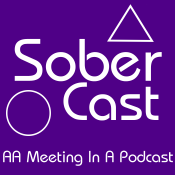(Listen to the episode referred to in this post.)
Initial growth in Alcoholics Anonymous took place in Cleveland, Ohio. Clarence S. and the guys went out actively pursuing drunks and brought them off bar stools and street corners. We don't do that today, but we were doing it back then [late 1930's and 1940's]. And it worked!
Brand-new AA's, sober only a month or even a week, had to sponsor alcoholics still drying up in hospitals.
In early 1940, when there were about 1,000 members of AA, more than half were from Cleveland. The book 'AA Comes of Age' talks about it on pages 20 and 21: "It was soon evident that a scheme of personal sponsorship would have to be devised for the new people. Each prospect was assigned an older AA, who visited him at his home or in the hospital, instructed him on AA principles, and conducted him to his first meeting." So even back in the early days the sponsor was taking the sponsee to meetings and getting together with him, rather than having the sponsee track the sponsor down. 'AA Comes of Age' continues by saying, "But in the face of many hundreds of pleas for help, the supply of elders could not possibly match the demand. Brand-new AA's, sober only a month or even a week, had to sponsor alcoholics still drying up in hospitals." Because of this rapid growth in Cleveland, the idea of formalized classes started. In the book 'Dr. Bob and the Good Old-timers' it states on page 261, "Yes, Cleveland's results were the best. Their results were in fact so good that many a Clevelander really though AA had started there in the first place." Over half of the fellowship was from Cleveland up and through the mid-1940s.
During the winter of 1941 the Crawford Group (founded in February 1941) organized a separate group to help newcomers through the Steps. By the first issue of the Cleveland Central Bulletin, October 1942, the Crawford "Beginners' Class" was listed as a separate meeting. And in the second issue, in November 1942, there was an article entitled "Crawford Men's Training". This refers to possibly the first "Beginners' Class". "The Crawford Men's Training System has been highly acclaimed to many. Old AA's are asked to come to these meetings with or without new prospects, where new prospects will be given individual attention just as though they were in a hospital. Visiting a prospect in his home has always been handicapped by interruptions. But the prospect not daring to unburden himself completely for fear of being overheard by his relatives and by the AA's reticence for the same reason. Hospitalization without question is the ideal answer to where the message will be most effective; but the Crawford training plan strikes us as being the next best." In the early days they weren't sure if you could get sober if you didn't go to treatment. That was one of the early questions - could a person get sober without going to a three or five-day detox. Because it was during that detox that sometimes ten and twenty AA members came to visit the new person. And each hour the prospect was awake he would hear someone's story - over and over again. And something gelled during these hospital stays. But they were trying to do it outside of the hospital and this is where the first of the classes came from.
The newcomer is not permitted to attend a regular AA meeting until he has been given a thorough knowledge of the work.
These classes continued at Euclid Avenue Meeting Hall through June 1943 and at that time the Central Bulletin announced a second session - "The Miles Training Meeting". The bulletin read, "The Miles Group reports they have enjoyed unusual success with their training meetings. The newcomer is not permitted to attend a regular AA meeting until he has been given a thorough knowledge of the work." The newcomer couldn't go to a meeting until he completed the training session. A lot of places didn't allow you to go to AA meetings until you had taken the four classes. You didn't just sit there - you had already completed the steps when you went to your first AA meeting. "From 15 to 20 participate at each training meeting and new members are thoroughly indoctrinated."
These meetings grew and spread and visitors came from out of town and out of state. In 1943 the Northwest Group in Detroit, Michigan standardized the classes into four sessions. "In June 1943 a group of members proposed the idea of a separate discussion meeting to more advantageously present the Twelve Steps of the recovery program to the new affiliates. The decision was made to hold a Closed Meeting for alcoholics only for this purpose. The first discussion meeting of the Northwest Group was held on Monday night June 14, 1943 and has been held every Monday night without exception thereafter (as of 1948). A plan of presentation of the Twelve Steps of the recovery program was developed at this meeting. The plan consisted of dividing the Twelve Steps into four categories for easier study." The divisions were:
- The Admission
- Spiritual
- Restitution and Inventory
- Working and the message
"Each division came to be discussed on each succeeding Monday night in rotation This method was so successful that it was adopted first by other groups in Detroit and then throughout the United States. Finally the format was published in it's entirety by the Washington, DC Group in a pamphlet entitled 'An interpretation of our Twelve Steps." The first pamphlet was published in 1944 and contains the following introduction: "Meetings are held for the purpose of aquatinting both the old and new members with the Twelve Steps on which our Program is based. So that all Twelve Steps may be covered in a minimum of time they are divided into four classifications. One evening each week will be devoted to each of the four subdivisions. Thus, in one month a new man can get the bases of our Twelve Suggested Steps." This pamphlet was reproduced many times in Washington, DC and then throughout the country and is even still being printed in some areas today.
In the Fall of 1944, a copy of the Washington, DC pamphlet reached Barry C. - one of the AA pioneers in Minneapolis. He wrote a letter to the New York headquarters requesting permission to distribute the pamphlet. We talk about "Conference Approved Literature" today; but this is the way the Fellowship operated back then. This is a letter from Bobby B., Bill W.'s secretary, printed on "Alcoholic Foundation" stationary. This is what she says:
"The Washington pamphlet, like the new Cleveland one, and a host of others, are all local projects. We do not actually approve or disapprove these local pieces. By that I mean the Foundation feels that each group is entitled to write up their own 'can opener' and to let it stand on it's own merits. All of them have their good points and very few have caused any controversy. But in all things of a local nature we keep hands off - either pro or con. Frankly, I haven't had the time to more than glance at the Washington booklet, but I've heard some favorable comments about it. I think there must be at least 25 local pamphlets now being used and I've yet to see one that hasn't some good points."
And then in 1945 the AA Grapevine printed three articles on the "Beginners' Classes". The first one was published in June and it described how the classes were conducted in St. Louis, Missouri. This has to do with the "education plan" and they called it the Wilson Club. "One of the four St. Louis AA groups is now using a very satisfactory method of educating prospects and new members. It has done much to reduce the number of 'slippers' among new members. In brief it is somewhat as follows: Each new prospect is asked to attend four successive Thursday night meetings. Each one of which is devoted to helping the new man learn something about Alcoholics Anonymous, it's founding and the way it works. The new man is told something about the book and how this particular group functions. Wilson Club members are not considered full active members of AA until they've attended these four educational meetings."
We feel that unless a man, after a course of instruction and an intelligent presentation of the case for the AA life, has accepted it without any reservation he should not be included in group membership.
In the September 1945 issue of the Grapevine the Genesee Group in Rochester, NY explained their format for taking newcomers through the Steps. The title of the article was "Rochester Prepares Novices for Group Participation". This is how they perceived the recovery process to operate most efficiently: "It has been our observation that bringing men [and woman] into the group indiscriminately and without adequate preliminary training and information can be a source of considerable grief and a cause of great harm to the general moral of the group itself. We feel that unless a man, after a course of instruction and an intelligent presentation of the case for the AA life, has accepted it without any reservation he should not be included in group membership. When the sponsors feel that a novice has a fair working knowledge of AA's objectives and sufficient grasp of it's fundamentals then he is brought to his first group meeting. Then he listens to four successive talks based on the Twelve Steps and Four Absolutes. They are twenty-minute talks given by the older members of the group and the Steps for convenience and brevity are divided into four sections. The first three Steps constitute the text of the first talk; the next four the second; the next four the third; and the last Step is considered to be entitled a full evening's discussion by itself." This group taught the Steps in order rather than in segments.
In December 1945, the St. Paul, Minnesota Group wrote a full-page description of the "Beginners' Meetings". The description of their four one-hour classes was: "New members are urged to attend all the sessions in the proper order. At every meeting the three objectives of AA are kept before the group: to obtain and to recover from those things which caused us to drink and to help others who want what we have." In 1945 Barry C., of Minneapolis, received a letter from one of the members from the Peoria, Illinois Group. In the letter, the writer, Bud, describes the efforts of Peoria, Illinois in regarding the "Beginners' Classes". "In my usual slow and cautious matter I proceeded to sell the Peoria Group on the Nicollet Group. Tomorrow night we all meet to vote the adoption of our bylaws slightly altered to fit local conditions". (No one taught the classes the same way. They were taught based on a group conscience.) "Sunday afternoon at 4:30 our first class in the Twelve Steps begins. We're all attending the first series of classes so we'll all be on an even footing. We anticipate on losing some fare-whether AA hangers-on in the elimination automatically imposed by the rule that these classes must be attended. This elimination we anticipate with a "we" feeling of suppressed pleasure. It is much as we are all extremely fed up with running a free drunk taxi and sobering-up service."
Then sometime prior to 1946 in Akron, Ohio the Akron Group started publishing four pamphlets on the AA Program. They were written by Ed W. at the direction of Dr. Bob, one of the co-founders of AA. Dr. Bob wanted some "blue-collar" pamphlets for the Fellowship. In one of the pamphlets, "A Guide to the Twelve Steps", it reads: "A Guide to the Twelve Steps of Alcoholics Anonymous is intended to be a simple, short and concise interpretation of the rules for sober living as compiled by the earliest members of the organization. The writers and editors are members of the Akron, Ohio Group where Alcoholics Anonymous was founded in 1935. Most of the ideas and explanations were brought out in a series of instruction classes conducted by veteran members of the group." So this proves the classes were being taught in Akron, Ohio. There are a lot of places they were being taught.
Then the classes were actually formalized into a book called "The Little Red Book" in 1946. The inscription on the inside cover says, "The material in this Little Red Book is an outgrowth of a series of notes originally prepared for Twelve Step instruction to AA beginners." So we know the "Little Red Book" came out of these four one-hour classes also. "Few books have had greater record for humble service than the Little Red Book upon which so many members have cut their AA teeth." A manuscript drawn up from these notes was sent to Dr. Bob at the request of USA and Canadian members. He approved the manuscript and the book was published in 1946. Dr. Bob approved of "The Little Red Book". So Dr. Bob not only authorized the publication of the Akron pamphlets, he also endorsed "The Little Red Book", both of which were products of the "Beginners' Classes".
Even our first AA group handbook, originally entitled "A Handbook for the Secretary", published by the Alcoholic Foundation in 1950, had a section on the "Beginners' Classes". At the time there were only three types of meetings: Open Speaker Meetings, Closed Discussion Meetings, and Beginners' Meetings. There was no such thing as an Open Discussion Meeting in the early days of Alcoholics Anonymous. In the Beginners' Meetings, which are described in the Meeting section, the handbook states: "In larger metropolitan areas a special type of meeting for newcomers to AA is proved extremely successful. Usually staged for a half-hour prior to an open meeting, this meeting features an interpretation of AA usually by an older member presented in terms designed to make the program clear to the new member. (Note: The Chicago Group held their "Beginners' Classes" a half-hour prior to their Open Meeting. When publishing the group handbook, the New York office only described Chicago's format.) After the speaker's presentation the meeting is thrown open to questions." In each of the four one-hour classes there was always a session for questions afterwards. "Occasionally, the AA story is presented by more than one speaker. The emphasis remains exclusively on the newcomer and his problem."
The four one-hour classes were taught all over the country. Some other cities include Oklahoma City, Miami Florida, and Phoenix Arizona.
What was originally conceived as a very simple program, which took a few hours to complete, evolved into a complicated and confusing undertaking requiring several months.
If these classes were so important, then what happened to them? Most of the people who have joined AA in the last twenty-five years or so have never even heard of them. Ruth R., an old-timer in Miami Florida, who came into AA in 1953, gave some insight into the demise of the "Beginners' Classes". "At that time the classes were being conducted at the Alana Club in Miami - two books were used: "Alcoholics Anonymous" (Big Book) and the "Little Red Book". Jim and Dora H., Florida AA pioneers, were enthusiastic supporters and they helped organize several of the classes and served as instructors." (Note: Dora was a Panel 7 Delegate to the General Service Office.) Ruth recalled that the classes were discontinued in the mid-1950s as the result of the publication of the book "Twelve Steps and Twelve Traditions" by Alcoholics Anonymous Publishing Inc. In the Miami area the "Twelve and Twelve" replaced both the "Big Book" and the "Little Red Book" and "Step Studies" replaced the "Beginners' Classes". In the process, the period for taking the Steps was expanded and modified from 4 weeks to somewhere in between 12 and 16 weeks. The Fourth Step inventory was modified and became a much more laborious and detailed procedure. What was originally conceived as a very simple program, which took a few hours to complete, evolved into a complicated and confusing undertaking requiring several months.
Studying the Steps is not the same as taking the Steps. In the "Beginners' Classes" you take the steps. The Big Book says, "Here are the steps we took" not "here are the steps we read and talked about." The AA pioneers proved that action, not knowledge, produced the spiritual awakening that resulted in recovery from alcoholism. On page 88, the authors of the Big Book wrote, "It works-it really does. We alcoholics are undisciplined. So we let God discipline us in the simple way we have just outlined. But this is not all. There is action and more action. Faith without works is dead."
This concludes the description of the "Beginners' Classes" during Wally P.'s talk in Masa, Arizona on November 23, 1996.
Wally P. is an AA Archivist from Tucson, Arizona. For two years he researched and studied areas of the country that held "Beginners' Classes". He then started teaching the classes under the guidance of his sponsor who took the classes in 1953 and never drank again. In March of 1996 Wally mentioned the "Beginners' Classes" as part of his historical presentation at the Wilson House in East Dorset, Vermont. Wally then wrote and published a book entitled "Back to Basics: The Alcoholics Anonymous Beginners' Classes - Take all 12 Steps in Four One-Hour Sessions." Wally P. has a website containing much information on the AA "Beginners' Classes".
I have removed the url to the website he mentions above because it no longer exists, however if you are interested in ordering Wally P's book it is still in print and can be ordered here.
Reprinted from: https://goo.gl/RQuVWC









